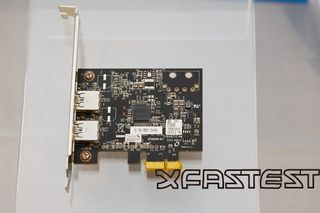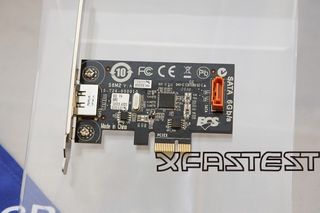ECS Also Providing USB 3.0 and SATA 6Gb/s Cards
ECS is also releasing two PCI-Express cards for USB 3.0 and SATA 6 Gb/s.

It looks as if a good handful of manufacturers is ignoring Intel's hesitancy and is jumping on the USB 3.0 / SATA 6 Gb/s bandwagon. ECS is the latest to produce new hardware, sporting two tasty PCI-Express expansion cards: one providing USB SuperSpeed and one providing the new SATA. These PCI-E cards provide access to the new technology without the need for replacing the entire motherboard.

The news originally appeared on XFastest, however TechPowerUp translated the post, reporting that the cards use the NEC µPD720200 controller for the USB 3.0 version and the Marvell 88SE9123-NAA2 controller for the SATA 6 Gb/s version. According to the post, the USB 3.0 card provides both ports on the rear-panel; the SATA 6 Gb/s card provides one internal SATA port, and one eSATA 6 Gb/s connection.
Currently ECS has not released pricing or ship dates for either version, but we're expecting them to hit the market during Asus's and ASRock's launch window of similar products. There may be a drawback to using these cards however: both supposedly remain in 1x PCI-E format. If that is indeed the case (for who knows why in a 16x world), the narrow pipeline may limit the overall Mb/s speed.
Stay on the Cutting Edge
Join the experts who read Tom's Hardware for the inside track on enthusiast PC tech news — and have for over 25 years. We'll send breaking news and in-depth reviews of CPUs, GPUs, AI, maker hardware and more straight to your inbox.
-
tester24 Intel will realize it made big mistake by downplaying USB 3 like MS did with the internet. Not saying they are as big but I'm pretty sure I don't speak for myself when I say that I am sick of USB 2.0 slow speeds especially when it comes to external drives as well as flash drives.Reply -
doomtomb The co-inventor of USB works for Intel and yet they want to delay the new standard. What a bunch of dicks.Reply -
Computer_Lots Somebody needs to build a PCIx4 or X16 card with both USB 3.0 and SATA6 on a single card. This way anyone can just upgrade their existing PC to both new standards at once and only take up one more slot.Reply
Of course, neither of these will really be cost efficient until they are integrated on motherboards. -
anamaniac Computer_LotsSomebody needs to build a PCIx4 or X16 card with both USB 3.0 and SATA6 on a single card. This way anyone can just upgrade their existing PC to both new standards at once and only take up one more slot.Of course, neither of these will really be cost efficient until they are integrated on motherboards.True, integration would be nice...Reply
Also would be kind of cool if we just ditched SATA and eSATA altogether and used USB 3.0 only for all. I already have dozens of cables around my place, I don't need any more (plus SATA cables are too stiff for proper cable management).
I'd think one with two USB, 1 eSATA and two SATA would likely be the best on a 8x lane.
Now, how about PCIe 3.0?
And also how about GPUs recognizing what revision (PCIe 1.0, 2.0, 3.0 etc.) you have so it can detect how many external cables you need (PCIe 3.0 allowing all modern GPUs with any external cables). -
apache_lives Untill there are decent performing and cost effective devices for both USB3 and SATA3 its kind of useless but great to get the ball rolling for starters atleast.Reply
As for PCIe 1x - its 250mb/s both way, the USB3 card will be fine (atleast quicker then ~44mb/s USB2) but SATA3 on PCIe 1x is useless when an onboard SATA2 controller can push ~270mb/s - beyond PCIE 1x -
liquidsnake718 Thank you ECS..... after reading on Intel's decision to wait and see how the market will do without their usb3.0 support, I was discouraged to see a market leader "sit back" but now that Asus and ECS has stepped up to plate, this should wake intel up and push the market towards the medium and launch peripherals and the sort in 2010 for usb3.0!Reply
Overall, Im happy as I can start planning for a true future proof build....... -
tmc I've read one of the reasons WHY usb 3.0 is in endless delay is that the chipset currently developed can not get full spec bandwith utilization and that successive chipsets will get steadily better.. The whole point of getting usb was to (try) make sata 1-2 and usb 1-2.0 obsolete. Bandwidth is supposed to be in the 10gigabit range although devices certainly won't spit out that kind of bandwidth all by themselves, they are supposed to co-exist to suck up that thruput.Reply
I'd rather see this on the motherboard early next year than in add-on cards.. because motherboard designers really suck at making pci-e slots far enough apart so that they don't overlap with a video card. Generally on most boards, you lose a 1x pci-e slot during this tradeoff especially if you sli-crossfire config. When properly config'd a mb/ should have 2 x16 slots back-to-back (but far enough apart for cooling which means dont make them fatter than a 3.5" hard drive, dummies-- make cooler running chips!), an X1 or X4 slot, then 1 or 2(if there's room left) for legacy pci 2.X (without costing mega bucks $$)
** Then again, why not just make 2 x16 slots for video, and an x8 slot which can also pair down to 2 or 3 legacy pci slots with an adapter (yeah, how would that look? well, the x8 slot would utilize the next breakout on the case for wiring, obviously) 2010 is the year of new mobo sockets anyway.. might as well toss legacy pci as well. -
truerock USB 2.0 flash drives are much too slow. I hope this is the beginning of solving that problem.Reply
Most Popular

